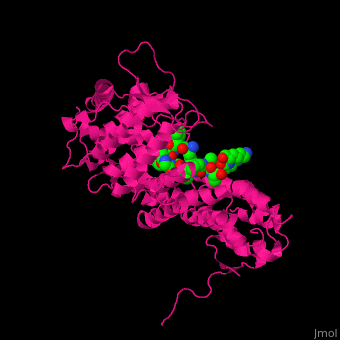Function
Menin or multiple endocrine neoplasia I (Men) is a putative tumor suppressor. Men possesses two functional nuclear localization signals and inhibits transcriptional activation by JunD[1].
Disease
Men mutations may be a common mechanism for inactivating tumor suppressor gene products in familial cancer[2].
Structural highlights
[3].
3D structures of menin
Updated on 18-December-2025
3u84, 7o9t – hMen – human
9c4w, 9c4x, 9c4y, 9c4z – hMen (mutant) <br /
4og3, 4og4, 4og5, 4og6, 4og7, 4og8, 6b41, 6bxh, 6bxy, 6by8, 6e1a, 6mnh, 6o5i, 6s2k, 6wnh, 7m4t, 7o9x, 7o9z, 7oa9, 9c92, 9c93, 9c94 – hMen + inhibitor
4gpq, 4gq3, 4gq4, 4x5y, 4x5z, 5db0, 5db1, 5db2, 5db3, 5dd9, 5dda, 5ddb, 5ddc, 5ddd, 5dde, 5ddf, 6pkc, 7uj4, 8e90, 8ig0 – hMen (mutant) + inhibitor
8va6, 9z4x – hMen + drug
8va5 – hMen (mutant) + drug
4i80, 6opj – hMen + peptide inhibitor
3u85 – hMen + histone-lysine N-methyltransferase Mll peptide
4gq6, 9c4s, 9c4t, 9c4u, 9c4v – hMen (mutant) + histone-lysine N-methyltransferase Mll peptide
3u86 – hMen + JunD peptide
3u88 – hMen + histone-lysine N-methyltransferase Mll + lens epithelium-derived growth factor
8gpn – hMen in nucleosome – Cryo EM
References
- ↑ Baillard C, Hellier P, Barillot C. Segmentation of brain 3D MR images using level sets and dense registration. Med Image Anal. 2001 Sep;5(3):185-94. PMID:11524225
- ↑ Yaguchi H, Ohkura N, Takahashi M, Nagamura Y, Kitabayashi I, Tsukada T. Menin missense mutants associated with multiple endocrine neoplasia type 1 are rapidly degraded via the ubiquitin-proteasome pathway. Mol Cell Biol. 2004 Aug;24(15):6569-80. PMID:15254225 doi:http://dx.doi.org/10.1128/MCB.24.15.6569-6580.2004
- ↑ Huang J, Gurung B, Wan B, Matkar S, Veniaminova NA, Wan K, Merchant JL, Hua X, Lei M. The same pocket in menin binds both MLL and JUND but has opposite effects on transcription. Nature. 2012 Feb 12;482(7386):542-6. doi: 10.1038/nature10806. PMID:22327296 doi:10.1038/nature10806

